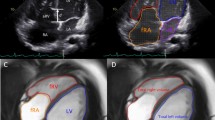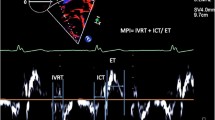Abstract
Detailed three-dimensional cardiac segmentations using cardiac computed tomography (CT) data is technically feasible in patients with Ebstein anomaly, but its complementary role has not been evaluated. This single-center, retrospective study was aimed to evaluate the complementary role of cardiac CT ventricular volumetry in evaluating the severity of Ebstein anomaly. Preoperative cardiac CT ventricular volumetry was performed in 21 children with Ebstein anomaly. CT-based ventricular functional measures were compared between Carpentier types, and between definitive surgical repair types. The Celermajer severity index measured with echocardiography was correlated with CT-based functional parameters. Total right ventricle (RV) and functional RV (fRV) volumes, fRV fraction, fRV/left ventricle (LV) volume ratio, and end-diastolic CT severity index demonstrated statistically significant differences between Carpentier type A/B and Carpentier type C/D (p < 0.05). The Celermajer severity index measured with echocardiography showed a high positive correlation with the end-diastolic CT severity index (R = 0.720, p < 0.002). There were no statistically significant differences in both echocardiography- and CT-based functional measures between patients with biventricular repair and patients with one-and-a-half or univentricular repair (p > 0.05). Compared with echocardiography, cardiac CT ventricular volumetry can provide the severity of Ebstein anomaly objectively and may be used in select patients when echocardiographic results are inconclusive or inconsistent.

Similar content being viewed by others
Data Availability
Data are held in a secure, password protected format at the medical center.
References
Alsaied T, Christopher AB, Da Silva J, Gupta A, Morell VO, Lanford L et al (2023) Multimodality imaging in Ebstein anomaly. Pediatr Cardiol 44:15–23. https://doi.org/10.1007/s00246-022-03011-x
Neumann S, Rüffer A, Sachweh J, Biermann D, Herrmann J, Jerosch-Herold M et al (2021) Narrative review of Ebstein’s anomaly beyond childhood: Imaging, surgery, and future perspectives. Cardiovasc Diagn Ther 11:1310–1323. https://doi.org/10.21037/cdt-20-771
Carpentier A, Chauvaud S, Macé L, Relland J, Milhaileanu S, Marino JP et al (1988) A new reconstructive operation for Ebstein’s anomaly of the tricuspid valve. J Thorac Cardiovasc Surg 96:92–101
Celermajer DS, Bull C, Till JA, Cullen S, Vassillikos VP, Sullivan ID et al (1994) Ebstein’s anomaly: presentation and outcome from fetus to adult. J Am Coll Cardiol 23:170–176. https://doi.org/10.1016/0735-1097(94)90516-9
Cieplucha A, Trojnarska O, Bartczak-Rutkowska A, Kociemba A, Rajewska-Tabor J, Kramer L et al (2019) Severity scores for Ebstein anomaly: credibility and usefulness of echocardiographic vs magnetic resonance assessments of the Celermajer index. Can J Cardiol 35:1834–1841. https://doi.org/10.1016/j.cjca.2019.08.003
Geerdink LM, van Everdingen WM, Kuipers IM, Fejzic Z, du Marchie Sarvaas GJ, Frerich S et al (2023) Comprehensive evaluation of pediatric patients with Ebstein anomaly requires both echocardiography and cardiac magnetic resonance imaging. Pediatr Cardiol 44:75–85. https://doi.org/10.1007/s00246-022-02948-3
Hösch O, Sohns JM, Nguyen TT, Lauerer P, Rosenberg C, Kowallick JT et al (2014) The total right/left-volume index: a new and simplified cardiac magnetic resonance measure to evaluate the severity of Ebstein anomaly of the tricuspid valve: a comparison with heart failure markers from various modalities. Circ Cardiovasc Imaging 7:601–609. https://doi.org/10.1161/CIRCIMAGING.113.001467
Rydman R, Shiina Y, Diller GP, Niwa K, Li W, Uemura H et al (2018) Major adverse events and atrial tachycardia in Ebstein’s anomaly predicted by cardiovascular magnetic resonance. Heart 104:37–44. https://doi.org/10.1136/heartjnl-2017-311274
Goo HW (2019) Volumetric severity assessment of Ebstein anomaly using three-dimensional cardiac CT: a feasibility study. Cardiovasc Imaging Asia 3:61–67. https://doi.org/10.22468/cvia.2019.00052
Celermajer DS, Cullen S, Sullivan ID, Spiegelhalter DJ, Wyse RK, Deanfield JE (1992) Outcome in neonates with Ebstein’s anomaly. J Am Coll Cardiol 19:1041–1046. https://doi.org/10.1016/0735-1097(92)90291-t
Negoi RI, Ispas AT, Ghiorghiu I, Filipoiu F, Negoi I, Hostiuc M et al (2013) Complex Ebstein’s malformation: defining preoperative cardiac anatomy and function. J Card Surg 28:70–81. https://doi.org/10.1111/jocs.12032
Goo HW (2010) State-of-the-art CT imaging techniques for congenital heart disease. Korean J Radiol 11:4–18. https://doi.org/10.3348/kjr.2010.11.1.4
Goo HW (2011) Individualized volume CT dose index determined by cross-sectional area and mean density of the body to achieve uniform image noise of contrast-enhanced pediatric chest CT obtained at variable kV levels and with combined tube current modulation. Pediatr Radiol 41:839–847. https://doi.org/10.1007/s00247-011-2121-4
Goo HW (2018) Comparison of chest pain protocols for electrocardiography-gated dual-source cardiothoracic CT in children and adults: the effect of tube current saturation on radiation dose reduction. Korean J Radiol 19:23–31. https://doi.org/10.3348/kjr.2018.19.1.23
Hong SW, Goo HW, Maeda E, Choo KS, Tsai IC; Asian Society of Cardiovascular Imaging Congenital Heart Disease Study Group (2019) User-friendly, vendor-specific guideline for pediatric cardiothoracic computed tomography provided by the Asian Society of Cardiovascular Imaging (ASCI) Congenital Heart Disease Study Group: Part 1. Imaging Tech Korean J Radiol 20:190–204. https://doi.org/10.3348/kjr.2018.0571
Goo HW (2018) Is it better to enter a volume CT dose index value before or after scan range adjustment for radiation dose optimization of pediatric cardiothoracic CT with tube current modulation? Korean J Radiol 19:692–703. https://doi.org/10.3348/kjr.2018.19.4.692
Han BK, Grant KI, Garbrich R, Sedlmair M, Lindberg J, Lesser JR (2012) Assessment of an iterative reconstruction algorithm (SAFIRE) on image quality in pediatric cardiac CT datasets. J Cardiovasc Comput Tomogr 6:200–204. https://doi.org/10.1016/j.jcct.2012.04.008
Lee KB, Goo HW (2020) Comparison of quantitative image quality of cardiac computed tomography between raw-data-based and model-based iterative reconstruction algorithms with an emphasis on image sharpness. Pediatr Radiol 50:1570–1578. https://doi.org/10.1007/s00247-020-04741-x
Goo HW (2012) CT radiation dose optimization and estimation: an update for radiologists. Korean J Radiol 13:1–11. https://doi.org/10.3348/kjr.2012.13.1.1
Goo HW (2019) Semiautomatic three-dimensional threshold-based cardiac computed tomography ventricular volumetry in repaired tetralogy of Fallot: comparison with cardiac magnetic resonance imaging. Korean J Radiol 20:102–113. https://doi.org/10.3348/kjr.2018.0237
Sugeng L, Mor-Avi V, Weinert L, Niel J, Ebner C, Steringer-Mascherbauer R et al (2010) Multimodality comparison of quantitative volumetric analysis of the right ventricle. JACC Cardiovasc Imaging 3:10–18. https://doi.org/10.1016/j.jcmg.2009.09.017
Yu S, Yang K, Chen X, Lu M, Zhao K, Yang S et al (2023) Cardiac remodeling after tricuspid valve repair in Ebstein’s anomaly: a magnetic resonance study. Eur Radiol 33:2052–2061. https://doi.org/10.1007/s00330-022-09190-8
Prota C, Di Salvo G, Sabatino J, Josen M, Paredes J, Sirico D et al (2019) Prognostic value of echocardiographic parameters in pediatric patients with Ebstein’s anomaly. Int J Cardiol 278:76–83. https://doi.org/10.1016/j.ijcard.2018.10.046
Homzova L, Photiadis J, Sinzobahamvya N, Ovroutski S, Cho MY, Schulz A (2021) Surgical management of Ebstein anomaly: impact of the adult congenital heart disease anatomical and physiological classifications. Interact Cardiovasc Thorac Surg 32:593–600. https://doi.org/10.1093/icvts/ivaa294
Zhu Y, Liu J, Weinsaft J, Spincemaille P, Nguyen TD, Prince MR et al (2015) Free-breathing 3D imaging of right ventricular structure and function using respiratory and cardiac self-gated cine MRI. Biomed Res Int 2015:819102. https://doi.org/10.1155/2015/819102
Hanneman K, Kino A, Cheng JY, Alley MT, Vasanawala SS (2016) Assessment of the precision and reproducibility of ventricular volume, function, and mass measurements with ferumoxytol-enhanced 4D flow MRI. J Magn Reson Imaging 44:383–392. https://doi.org/10.1002/jmri.25180
Goo HW (2018) Comparison between three-dimensional navigator-gated whole-heart MRI and two-dimensional cine MRI in quantifying ventricular volumes. Korean J Radiol 19:704–714. https://doi.org/10.3348/kjr.2018.19.4.704
Alsaied T, Diaz-Castrillon C, Christopher A, Da Silva J, Morell VO, Lanford L et al (2022) Cardiac MRI predictors of right ventricular dysfunction after the Da Silva cone operation for Ebstein’s anomaly. Int J Cardiol Congenit Heart Dis 7:100342. https://doi.org/10.1016/j.ijcchd.2022.100342
Tang XJ, Bao M, Zhao H, Wang LY, Wu QY (2017) Intraoperative transesophageal echocardiography in the operation of Ebstein’s anomaly: a retrospective Study. Chin Med J (Engl) 130:1540–1543. https://doi.org/10.4103/0366-6999.208233
Funding
No funding was received to assist with the preparation of this manuscript.
Author information
Authors and Affiliations
Contributions
All named authors have been active participants in this research and have approved the manuscript for submission.
Corresponding author
Ethics declarations
Conflict of interest
The authors have no conflict of interest to declare that are relevant to the content of this article.
Ethical Approval
This retrospective study was approved by the local institutional Ethics Review Board and conducted with strict maintenance of patient anonymity.
Consent to Participate
The need for informed consent was waived by the local institutional Ethics Review Board.
Additional information
Publisher's Note
Springer Nature remains neutral with regard to jurisdictional claims in published maps and institutional affiliations.
Rights and permissions
Springer Nature or its licensor (e.g. a society or other partner) holds exclusive rights to this article under a publishing agreement with the author(s) or other rightsholder(s); author self-archiving of the accepted manuscript version of this article is solely governed by the terms of such publishing agreement and applicable law.
About this article
Cite this article
Goo, H.W., Park, S.H. Complimentary Cardiac Computed Tomography Ventricular Volumetry-Derived Metrics of Severity in Patients with Ebstein Anomaly: Comparison with Echocardiography-Based Severity Indices. Pediatr Cardiol 45, 24–31 (2024). https://doi.org/10.1007/s00246-023-03342-3
Received:
Accepted:
Published:
Issue Date:
DOI: https://doi.org/10.1007/s00246-023-03342-3




